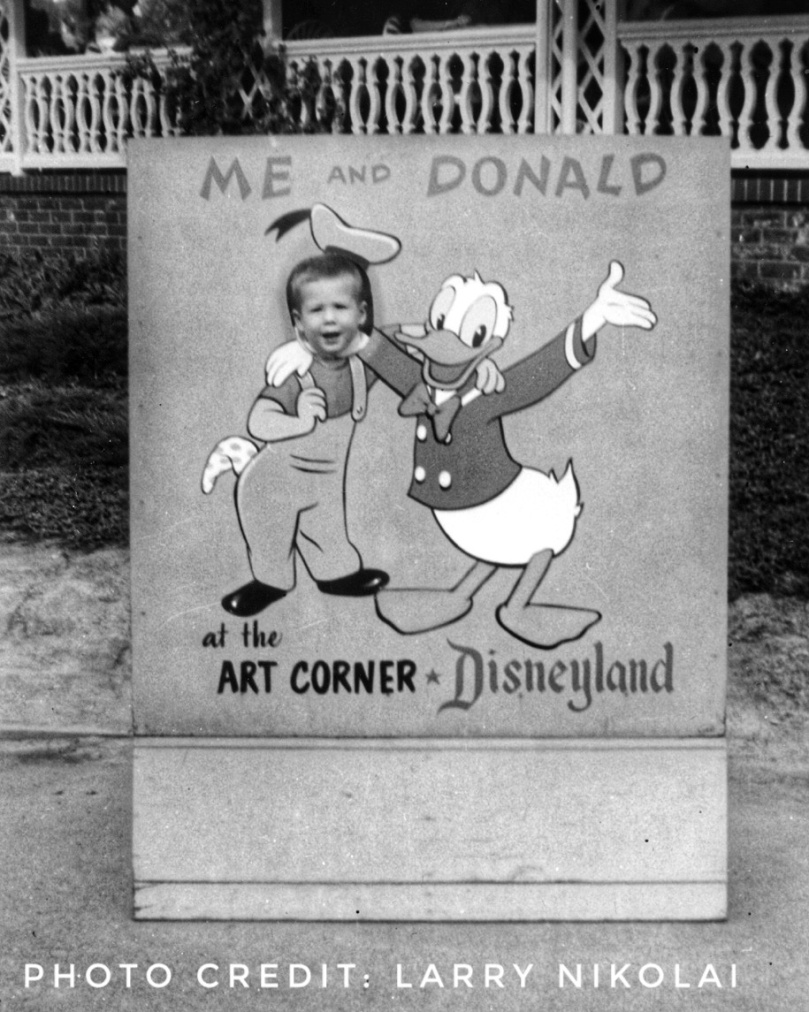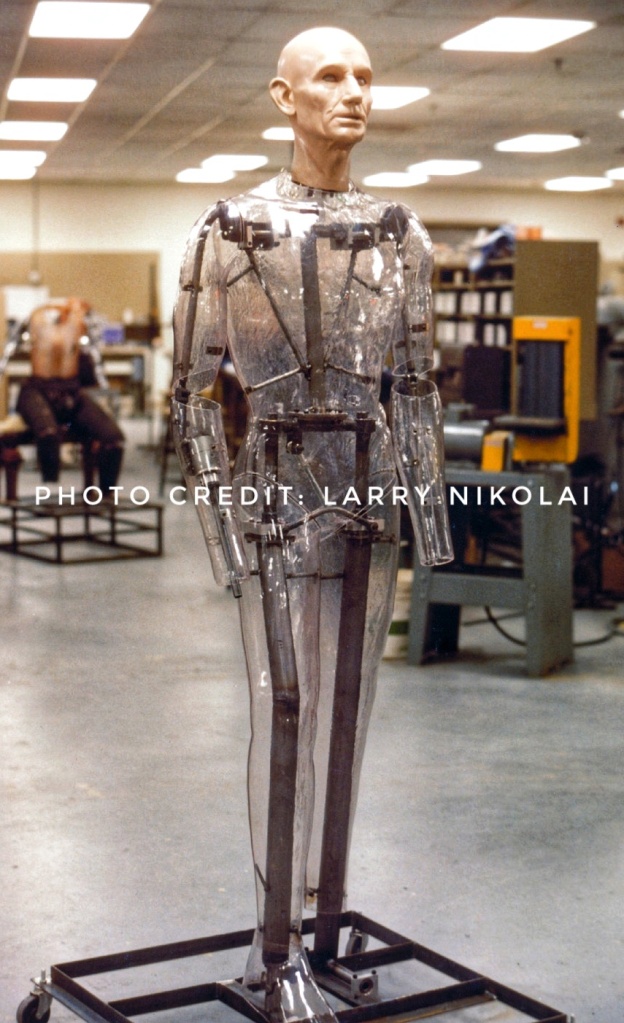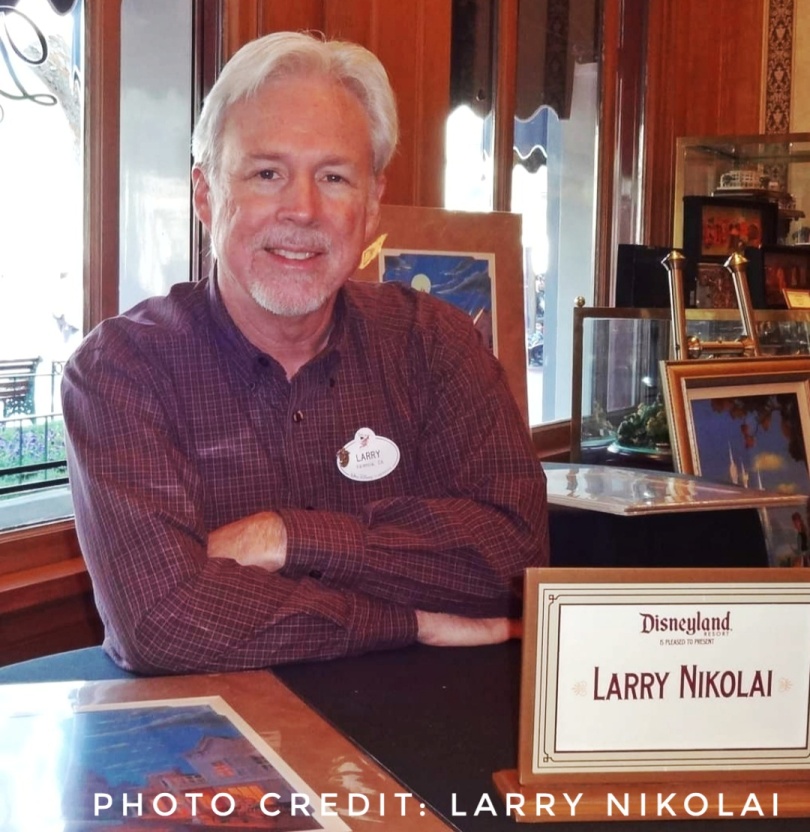Written By Catherine Ramirez
The 20th anniversary celebration of Tokyo DisneySea is on the near horizon. In my opinion, it is the most beautiful of all Disney theme parks I have ever had the privilege to work at and visit. Because of this momentous occasion, I thought the perfect person to reach out to would be the Walt Disney Imagineering (WDI) Lead Art Director for my favorite port of call, Arabian Coast, one of seven themed ports of call (lands) located inside Tokyo DisneySea. I have been wanting to learn more about the inspiration that led to the design of this beautiful land and knew that I needed to speak to none other than WDI alumnus, Larry Nikolai.

With a career at WDI spanning 28 years, I was excited to talk to Larry about many of his other projects as well, like “Ariel’s Undersea Adventure” at Disney California Adventure Park, Tokyo Disneyland’s “Haunted Mansion Holiday Nightmare,” his work as a Disney Gallery Artist, and the merchandise collectibles he designed for the Parks like the Main Street Electrical Parade Collectibles from 1996.
My initial interview with Larry led me down a path craving for many more questions to be answered. Larry graciously answered another round of questions about a month after our initial interview. What I have come to realize is that although I knew Nikolai was an Imagineer who worked on many projects (all of which were during my years of working for Disney and the Oriental Land Company (O.L.C.), what I understood after my interview was how truly little I did know about ALL of his projects. I yearned for a better understanding so that I could, in turn, introduce or reintroduce him to you. You may think you know Imagineer alumnus Larry Nikolai, but I’m not so sure you truly do, yet. My hope over the next few weeks and perhaps even months, as I continue to write my blog about Larry and his many contributions to the Walt Disney Company and its theme parks around the world, is that both you and I will have a better understanding of his many talents.
Ah yes, I must not forget, where to begin? Well, I do believe at the beginning is almost always the best place, so we’ll start there.
It All Started When He Was Two Years Old
Larry Nikolai was born in Kansas City, Missouri and moved to California in 1956 when he was just two years old. It would be that very same year his parents would take him to Disneyland. Larry explained to me the impact visiting the park had on him.
L: When my family moved to California from Kansas City in 1956, we visited Disneyland the first year we were here. After that it became an annual event, and I grew up with the park.

L: I was always fascinated with the attractions and in later years I made my own crude versions in my garage and backyard.
C: Can you tell me more about that?
L: I have always felt compelled to make dimensional objects with my own two hands- my early visits to Disneyland inspired me to want to have some of the magic in my own backyard and garage, so I had to create it myself!
C: What were some of the attractions you built and out of what materials?
L: I made some small Jungle Cruise elephants at first and graduated to very crude Lincoln figures after seeing the show when it first opened at Disneyland (1965). When Pirates came along (1967), I had to make my own walk-through version with a few figures and lighting effects. Everything I built was of the crudest materials- scrap wood, cardboard, wooden produce crates, paper mâché, plaster, used clothing and some homemade vacuum-formed plastic faces. I also made a number of Tiki birds with string-puppeted mouths.
C: Do you have any photos you could share?
L: I am WAY too embarrassed to show any photos of those very crude early creations!
Although Larry was too embarrassed to show me any photos of his childhood creations, he did let me know that his parents and family were all very supportive of him, sitting through many “garage-based Lincoln shows.” There were apparently many shows as Larry would continue to work on his Lincoln, improving his version overtime. Nikolai’s Pirates of the Caribbean however, as Larry states, “lasted just a season and a few viewings.”
C: Were you always an artist? Even as a young child?
L: I can’t remember a time when I wasn’t drawing or creating something. My favorite first cartoon character was Popeye, so he is the first thing that I drew. I never really cared for coloring books because I wanted to make the pictures myself, and when we made cards for Mother’s or Father’s Day in school I used to put characters in them. And I’ve always had a desire to paint, even if I didn’t know how to properly use the materials. I once painted a portrait of a sea captain using tubed watercolor paints straight out of the tubes on canvas. I treated them like oil paints. It paid off in the end, though- I entered the painting in a junior art show at a local shopping center and won second prize.
C: I had read that you are both a classically trained fine artist and animation designer. Where did you obtain your training?
L: I took art classes in high school, but to be honest I didn’t pay much attention to them as at the time I was more interested in theater and film making. After high school I attended California State University at Northridge where I concentrated more on my art and earned a bachelor’s degree in fine art 2-D painting. When I say I’m a classically trained artist I mean that I went through the classic process of life drawing and learning the various mediums and how to properly use them. I also took the required art history courses and available 3-D design classes to round out my education.
“I OWE EVERYTHING TO THIS MAN”
C: How did you get into theme park attraction design?
L: I was working in the Merchandise Department at Six Flags Magic Mountain during and right after college, and one day it just struck me that- because I loved Disneyland since I could remember- it made sense to bring my art and Disney together for my career. I applied at WED (Walter Elias Disney Enterprises, now Walt Disney Imagineering) but did not have enough experience to get hired there at the time. I stayed at Magic Mountain and a couple of years later I met David Gengenbach, an ex-Disney executive who was also working there.

David Gengenbach Photo Credit Walt Disney Company 
David Gengenbach Photo Credit Advanced Animations
David Gengenbach worked for the Walt Disney Company as both a project engineer, project manager, and later the vice president of Walt Disney’s WED Enterprises. He oversaw many of the Magic Kingdom’s attractions at Walt Disney World including Space Mountain, the Mark III and Mark IV monorail systems, and the Carousel of Progress. After twelve years with the Walt Disney Company, David left Disney to work for Six Flags Corporation as Manager of Corporate Engineering.

L: He saw a little raccoon sculpture I had done and said that the company was planning to do a dark ride at the Atlanta Park, and that I could join the team if it was approved. I owe everything to this man and mentor who took a chance on me, because the ride “Monster Plantation“ was approved and suddenly I became a professional artist working through the Six Flags Engineering department on a real theme park attraction.
L: On that project (Monster Plantation) I worked with some very talented ex-Disney (and non-ex-Disney) folks, and with their help I ended up working in the theme park, movies, publishing, and cartoon animation industries for the next 12 years before finally being hired at Imagineering.
Almost an Imagineer…But First…One More Question
C: Please tell me a little bit more about the 12 years before finally becoming an Imagineer with the Walt Disney Company. Films you worked on, cartoon animation, and theme parks.
L: The 12 years includes a couple of years still at Magic Mountain before I met Dave Gengenbach and was brought onto the Monster Plantation project.
After Monster Plantation it turns out that Six Flags no longer needed me, so I made the move over to the company that produced all of Monster Plantation’s animatronic figures, AVG Productions. I mostly worked on shows that fulfilled the pizza restaurant craze of the 1980s. I also worked on a show for Six Flags’ Movieland Wax Museum, “The Black Box.” While at AVG I met and worked with many Disney alumni, including Rolly Crump and “Big Al” Bertino.
Shortly after this, my mentor Dave Gengenbach was hired as president of Advanced Animations in Connecticut, and he invited me and some other AVG colleagues to join him there. I moved my family to the East Coast, where we thought we would be for at least 5 years. We did a number of conceptual proposals and some small to mid-size shows for the mostly local eastern states, including a chance for me to finally sculpt a real Abraham Lincoln animatronic figure for a museum in Gettysburg.
Nikolai Meets Lincoln

In 1965, at 11 years old, Nikolai became instantly fascinated with Abraham Lincoln when he saw the 16th President of the United States stand on Disneyland’s Lincoln Theater stage in “Great Moments with Mr. Lincoln.” Just as Walt Disney was fascinated with the beloved president at a young age, so was Larry Nikolai, who would go on to study Lincoln’s life.
The opportunity to finally sculpt the head of Abraham Lincoln must have been exhilarating for Nikolai. The many childhood attempts of creating Lincoln in his garage would finally pay off. Larry would sculpt the head while another sculptor created the body for the animatronic figure who would deliver the Gettysburg Address at the Civil War Wax Museum in Gettysburg.
Larry personally owns copies of the famous Abraham Lincoln life mask and hands that were created by Leonard W. Volk, Chicago sculptor, on March 31, 1860. Volk created the mold prior to Lincoln’s nomination as the Republican presidential candidate. It involved a process that encased Lincoln’s face and ears in plaster. The plaster was left on his face for about an hour to dry and set and was then carefully removed from Lincoln’s face. A process Lincoln is reported to have said was, “anything but agreeable.” It would be this mold that would become the reference for artists who would create busts and statues of Lincoln including Imagineer Blaine Gibson who would also use the Volk mask for Walt Disney’s audio-animatronic Abraham Lincoln. Nikolai explained that the Volk mask that both Blaine and he used as reference for Lincoln were invaluable as it provided them both with the measurements they would need to bring Lincoln to life.

Returning to California…Why So Soon?
L: A Warner Communications Company (the parent company of Advanced Animations), fell on hard economic times and they cancelled our projects and laid us off after only one year. Rather than look for work locally or start commuting to New York City I moved my family back to Los Angeles, the true hub of the entertainment industry.
After returning to LA, I was unexpectedly hired into the world of Saturday morning cartoon animation at Ruby Spears Productions. Ken Spears and Joe Ruby were the creators of Scooby Doo during their years at Hanna Barbera before leaving to start their own studio. I had never worked in 2-D or cartoon animation before, and I was lucky to be around some amazing artists who taught me the business. I was initially hired as a maquette sculptor, but I ended up transitioning and was lucky to have five years of working around some amazing professionals in the industry where I got the solid practice I really needed at drawing both background scenes and animated characters. I also did character and show concept work between seasons when new series ideas were being pitched to the networks.
Also at that time my network of friends and associates had grown considerably, and I did many freelance jobs: magazine illustration, film and television character design, collectible merchandise concepts, puppets and costumed character design for both Disney, and Universal Studios- among many other opportunities. I worked on a couple of “Nightmare on Elm Street” films, and I even got to work with Elvira, Mistress of the Dark on her first movie. They were busy years full of good practice in many fields.
All of this led up to 1990, when I was finally hired at WDI.




So cool. Looking forward to hearing more about Larry.
LikeLike
What a career! It’s always so interesting to hear how a person ends up where they do. Can’t wait for the next installment!
LikeLike
Awe thank you! I’m hoping to post part 2 this week.
LikeLike